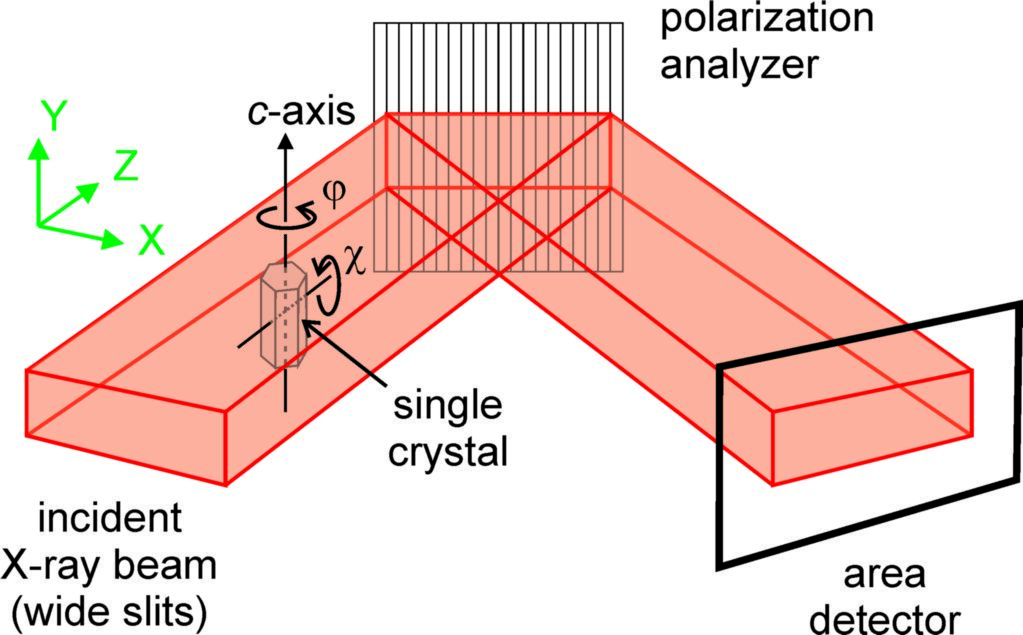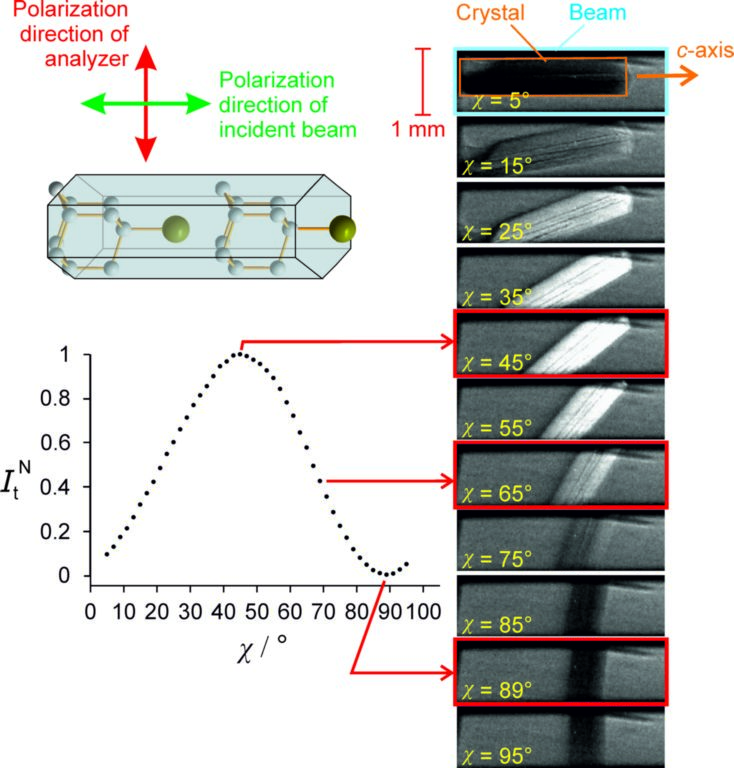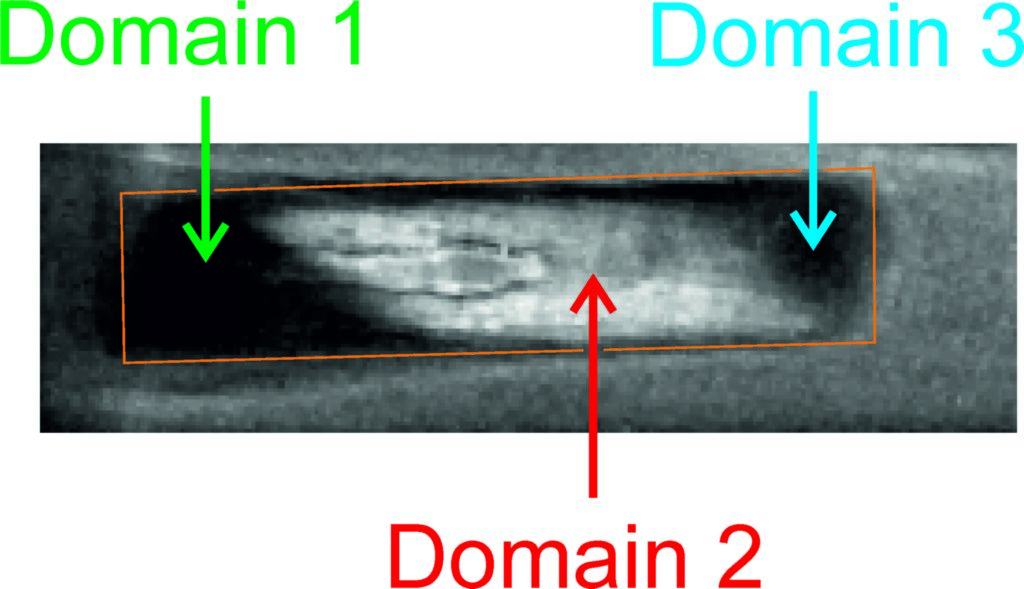 | ||
X-ray Birefringence Imaging |
Beamline B16 Scientific Highlight
The facilities available on the Test Beamline (B16) at Diamond Light Source have allowed, for the first time, an experiment to be carried out using a largearea linearly polarised X-ray beam and an area detector. This set-up allows mapping of individual regions (domains) within a sample containing different molecular orientations. Experiments reported in Science demonstrate XBI being used successfully in a range of experiments designed to selectively detect the orientations of C-Br bonds in brominated organic solids. The technique was also successful in identifying changes in molecular orientation during phase transitions. It is hoped that XBI be applied as an analytical tool to explore a wide range of materials science problems in the future, as the technique is not limited to crystalline materials and can be applied to any material with an anisotropic distribution of molecular orientations, including liquids and amorphous solids. It also gives the potential to carry out time-resolved studies due to the full-field nature of the technique.
Invented in the 19th Century, the polarising optical microscope has been used extensively since that time to investigate the structural anisotropy of materials. The operation of the polarising optical microscope1,2 is based on the phenomenon of optical birefringence (i.e., the refractive index of an anisotropic material depends on the orientation of the material with respect to the direction of linearly polarised incident radiation). When such a material is viewed in a polarising optical microscope in ‘crossed-polariser’ configuration, the intensity of observed light depends on the orientation of the ‘optic axis’ of the material relative to the direction of polarisation of the incident light. By measuring the intensity of transmitted light for different orientations of the material, the orientation of the optic axis within the material can be established. Furthermore, if the material comprises orientationally distinct domains, the spatial distribution and orientational relationships between the domains may be revealed.
The phenomenon of X-ray birefringence has been demonstrated only recently3,4,5. These previous studies used a narrowly focused X-ray beam and did not provide spatially resolved mapping of the material. This study proposed, for the first time, an experimental set-up (Fig. 1) that allows X-ray birefringence measurements to be carried out in a spatially resolved imaging mode, using a large-area linearly-polarised incident X-ray beam and an area detector. With this set-up, the X-ray birefringence of the material can be mapped in a spatially resolved manner, with resolution of the order of 10 μm.

Figure 1: Schematic of the experimental set-up on beamline B16 for X-ray Birefringence Imaging, which exploits linearly polarised X-rays from a synchrotron radiation source.

Figure 2: X-ray birefringence images recorded at 280 K for a single crystal of the 1-BA/thiourea inclusion compound (schematic of structure at top left) as a function of crystal orientation. The images are spatially resolved maps of transmitted X-ray intensity across the crystal. Relative brightness in the images scales with X-ray intensity.

Figure 3: X-ray birefringence image of a single crystal of the BrCH/thiourea inclusion compound at 20 K, showing clear evidence that the crystal comprises orientationally distinct domains (corresponding to regions with differing levels of brightness in the image).
Source publication:
Palmer, B. A., Edwards-Gau, G. R., Kariuki, B. M., Harris, K. D. M., Dolbnya, I. P. & Collins, S. P. X-ray birefringence imaging. Science 344, 1013-1016, doi:10.1126/science.1253537 (2014).
References:
1. Hartshorne, N. H., Stuart, A. Practical Optical Crystallography, Edward Arnold: London. (1969).
2. Kaminsky, W., Claborn, K. & Kahr, B. Polarimetric imaging of crystals. Chemical Society Reviews 33, 514-525, doi:10.1039/b201314m (2004).
3. Palmer, B. A., Morte-Rodenas, A., Kariuki, B. M., Harris, K. D. M. & Collins, S. P. X-ray Birefringence from a Model Anisotropic Crystal. Journal of Physical Chemistry Letters 2, 2346-2351, doi:10.1021/jz201026z (2011).
4. Palmer, B. A. et al. X-ray Birefringence: A New Strategy for Determining Molecular Orientation in Materials. Journal of Physical Chemistry Letters 3, 3216-3222, doi:10.1021/jz3013547 (2012).
5. Collins, S. P. et al. X-ray Birefringence in highly Anisotropic Materials. 11th International Conference on Synchrotron Radiation Instrumentation (Sri 2012) 425, doi:10.1088/1742-6596/425/13/132015 (2013).
Funding acknowledgements:
We are grateful to Diamond Light Source for the award of beam-time for experiments on beamline B16. We thank EPSRC (studentships to BAP and GREG) and Cardiff University for financial support.
Corresponding author:
Professor Kenneth Harris, Cardiff University, [email protected]


 A brighter light for science
A brighter light for science
